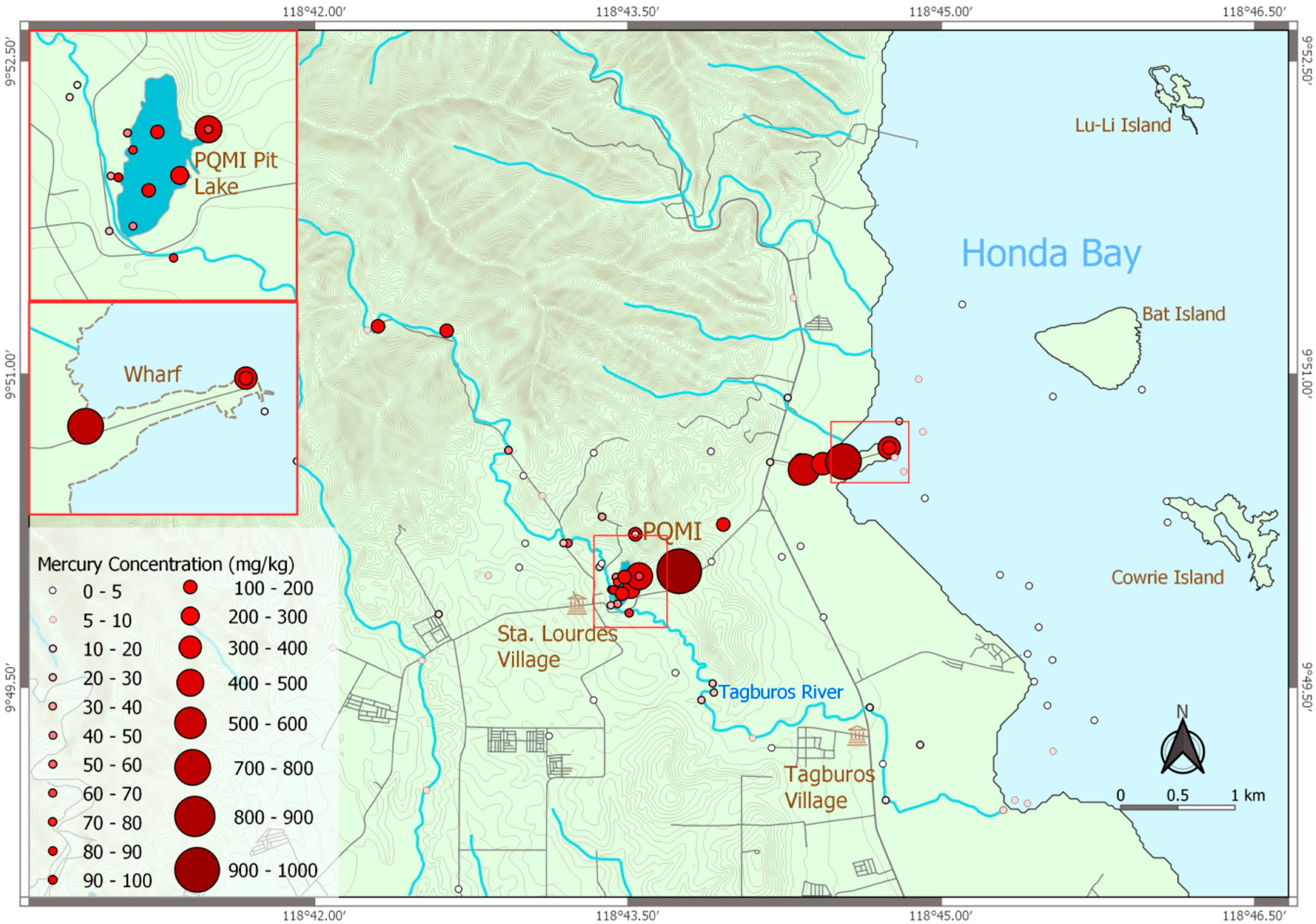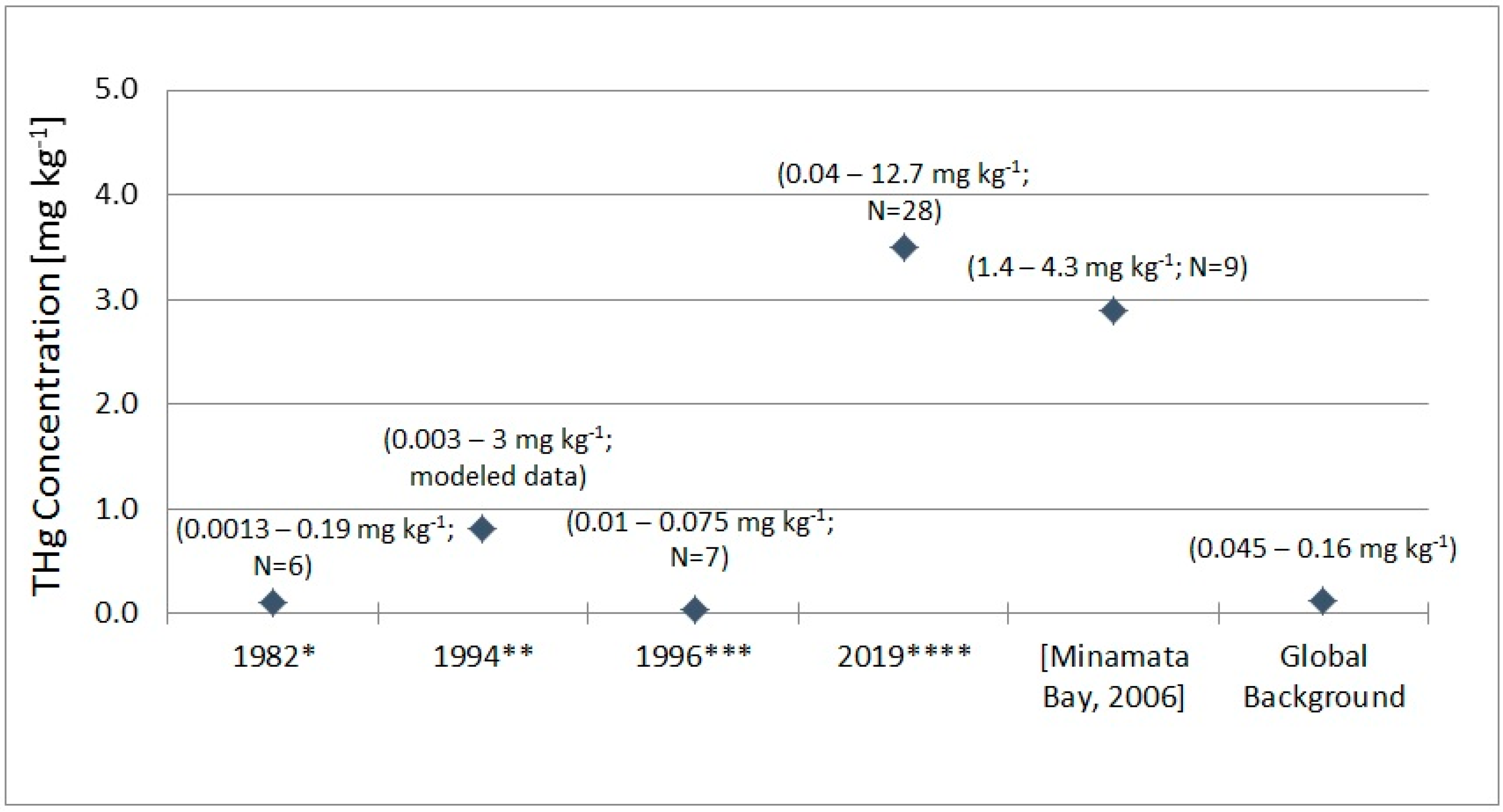Total Mercury in Soils and Sediments in the Vicinity of Abandoned Mercury Mine Area in Puerto Princesa City, Philippines
Abstract
1. Introduction
2. Materials and Methods
2.1. Study Area and Sampling Sites
2.2. Sampling
2.3. Total Mercury Analysis
3. Results and Discussion
3.1. THg in Mine Waste Calcines and Honda Bay Wharf
3.2. THg in Sediment in Tagburos River and Pit Lake
3.3. THg in Soils
3.4. THg in Honda Bay Sediment
3.5. THg of Sediment from Other Rivers
4. Conclusions
Author Contributions
Funding
Acknowledgments
Conflicts of Interest
References
- Samaniego, J.O.; Gibaga, C.R.L.; Tanciongco, A.M.; Rastrullo, R.M.; Costa, M.A.V. Surface water characteristics in the vicinity of abandoned mercury mine site in Puerto Princesa City, Philippines. Philipp. J. Sci. 2019, 148, 493–498. [Google Scholar]
- Selected Mercury Waste Hotspots around the World. Available online: https://ipen.org/sites/default/files/documents/mercury_waste_hotspots_world_map-en.pdf (accessed on 14 October 2019).
- Ordoñez, A.; Alvarez, R.; Charlesworth, S.; De Miguel, E.; Loredo, J. Risk assessment of soil contaminated by mercury mining, Northern Spain. J. Environ. Monit. 2011, 13, 128–136. [Google Scholar] [CrossRef]
- Higueras, P.; Lorenzo, S.; Esbrí, J.M.; García-Noguero, E.M.; Reyes-Bozo, L. Soil pollution related to mercury-mining activities in the proximity of Usagre (Badajoz, SW Spain). Int. J. Min. Reclam. Environ. 2014, 28, 377–388. [Google Scholar] [CrossRef]
- Qiu, G.; Feng, X.; Wang, S.; Shang, L. Environmental contamination of mercury from Hg-mining areas in Wuchuan, northeastern Guizhou, China. Environ. Pollut. 2006, 142, 549–558. [Google Scholar] [CrossRef] [PubMed]
- Qiu, G.; Feng, X.; Wang, S.; Shang, L. Mercury and methylmercury in riparian soil, sediments, mine-waste calcines, and moss from abandoned Hg mines in east Guizhou province, southwestern China. Appl. Geochem. 2005, 20, 627–638. [Google Scholar] [CrossRef]
- Gionfriddo, C.M.; Ogorek, J.M.; Butcher, M.; Krabbenhoft, D.P.; Moreau, J.W. Mercury distribution and mobility at the abandoned Puhipuhi mercury mine, Northland, New Zealand. N. Z. J. Geol. Geop. 2015, 58, 78–87. [Google Scholar] [CrossRef]
- Gray, J.E.; Crock, J.G.; Fey, D.L. Environmental geochemistry of abandoned mercury mines in West-Central Nevada, USA. Appl. Geochem. 2002, 17, 1069–1079. [Google Scholar] [CrossRef]
- Irving, E.M. Note on the first discovery of commercial mercury in the Philippines. Philipp. Geol. 1954, 9, 1–8. [Google Scholar]
- Williams, T.M.; Weeks, J.M.; Apostol, A.N.; Miranda, C.R. Assessment of mercury contamination and human exposure associated with coastal disposal of waste from a cinnabar mining operation, Palawan, Philippines. Environ. Geol. 1999, 39, 51–60. [Google Scholar] [CrossRef]
- Gray, J.E.; Greaves, I.A.; Bustos, D.M.; Krabbenhoft, D.P. Mercury and methylmercury contents in mine-waste calcine, water, and sediment collected from the Palawan Quicksilver Mine, Philippines. Environ. Geol. 2003, 43, 298–307. [Google Scholar] [CrossRef]
- Navarro, A.; Biester, H.; Mendoza, J.L.; Cardellach, E. Mercury speciation and mobilization in contaminated soils of the Valle del Azogue Hg mine (SE, Spain). Environ. Geol. 2006, 49, 1089–1101. [Google Scholar] [CrossRef]
- Wiederhold, J.G.; Smith, R.S.; Siebner, H.; Jew, A.D.; Brown, G.E.; Bourdon, B.; Kretzschmar, R. Mercury isotope signatures as tracers for Hg cycling at the New Idria Hg mine. Environ. Sci. Technol. 2013, 47, 6137–6145. [Google Scholar] [CrossRef] [PubMed]
- Yin, R.S.; Feng, X.B.; Meng, B. Stable mercury isotope variation in rice plants (Oryza sativa L.) from the Wanshan Mercury Mining District, SW China. Environ. Sci. Technol. 2013, 47, 2238–2245. [Google Scholar] [CrossRef]
- Fernandez-Martınez, R.; Rucandio, I. Total mercury, organic mercury and mercury fractionation in soil profiles from the Almadén mercury mine area. Environ. Sci. 2014, 16, 333–340. [Google Scholar] [CrossRef]
- Liu, J.; Shi, J.Z.; Yu, L.M.; Goyer, R.A.; Waalkes, M.P. Mercury in traditional medicines: Is cinnabar toxicologically similar to common mercurials? Exp. Biol. Med. 2008, 233, 810–817. [Google Scholar] [CrossRef]
- Regnell, O.; Watras, C.J. Microbial mercury methylation in aquatic environments—A critical review of published field and laboratory studies. Environ. Sci. Technol. 2019, 53, 4–19. [Google Scholar] [CrossRef]
- Harding, G.; Dalziel, J.; Vass, P. Bioaccumulation of methylmercury within the marine food web of the outer Bay of Fundy, Gulf of Maine. PLoS ONE 2018, 13. [Google Scholar] [CrossRef] [PubMed]
- Bernhoft, R.A. Mercury toxicity and treatment: A review of the literature. J. Environ. Public Health 2012, 2012. [Google Scholar] [CrossRef]
- Kapauan, A.F.; Kapauan, P.A.; Tan, E.O.; Verceluz, F. Total mercury in water and sediments from the Honda Bay area in Palawan. Philipp. J. Sci. 1982, 111, 135–144. [Google Scholar]
- Williams, T.M.; Weeks, J.M.; Apostol, A.; Miranda, C. Assessment of Toxicity Hazard Associated with Former Cinnabar Mining and Tailings Disposal in Honda Bay, Palawan, Philippines; British Geological Survey, Overseas Geology Series Technical Report WC/96/31; Keyworth: Nottingham, UK, 1996. [Google Scholar]
- Maramba, N.P.C.; Reyes, J.P.; Francisco-Rivera, A.T.; Panganiban, L.C.R.; Dioquino, C.; Dando, N.; Timbang, R.; Akagi, H.; Castillo, M.T.; Quitoriano, C.; et al. Environmental and human exposure assessment monitoring of communities near an abandoned mercury mine in the Philippines: A toxic legacy. J. Environ. Manag. 2006, 81, 135–145. [Google Scholar] [CrossRef]
- Rappler Philippines. Available online: https://www.rappler.com/nation/172410-widespread-mercury-poisoning-puerto-princesa-villages-palawan (accessed on 10 September 2019).
- Benoit, G.; Schwantes, J.M.; Jacinto, G.S.; Goud-Collins, M.R. Preliminary study of the redistribution and transformation of HgS from cinnabar mine tailings deposited in Honda Bay, Palawan, Philippines. Mar. Pollut. Bull. 1994, 28, 754–759. [Google Scholar] [CrossRef]
- Siegel, F.R. Environmental Geochemistry of Potentially Toxic Metals; Springer: Berlin, Germany, 2002; pp. 18–23. [Google Scholar]
- Tomiyasu, T.; Matsuyama, A.; Eguchi, T.; Fuchigami, Y.; Oki, K.; Horvat, M.; Rajar, R.; Akagi, H. Spatial variations of mercury in sediment of Minamata Bay, Japan. Sci. Total Environ. 2006, 368, 283–290. [Google Scholar] [CrossRef] [PubMed]




| Location | n | Total Hg (mg kg−1) |
|---|---|---|
| Palawan Hg mine, Philippines (This study) | ||
| Soils | 31 | 0.04–67.5 |
| Mine waste calcines | 7 | 52.7–924.2 |
| Palawan Hg mine, Philippines [11,22] | ||
| Soils | 21 | 0.012–168.72 |
| Mine waste calcines | 11 | 3.68–660 |
| Wuchuan Hg mines, Guizhou, China [5] | ||
| Soils | * | 0.33–320 |
| Mine waste calcines | * | 79–710 |
| East Guizhou Hg mines, China [6] | ||
| Soils | * | 5.1–790 |
| Mine waste calcines | * | 5.7–4400 |
| West-central Nevada Hg mines, USA [8] | ||
| Mine waste calcines | 36 | 1.9–2000 |
| Puhipuhi Hg mine, Northland, New Zealand [7] | ||
| Soils | 4 | 35.3–1486 |
| Almaden Hg mine, Spain [15] | ||
| Soils | 6 | 13–64 |
| Usagre Hg mine, Spain [4] | ||
| Soils | 26 | 0.2–311 |
| La Soterraña Hg mine, Northern Spain [3] | ||
| Soils | 56 | 1.73–502 |
| Branalamosa Hg mine, Northern Spain [3] | ||
| Soils | 28 | 0.5–895 |
| Maramuñiz Hg mine, Northern Spain [3] | ||
| Soils | 23 | 2.0–577 |
| Global background for pristine soils [25] | 0.045–0.16 |
| Site Location | n | Mean (Range) Concentration (mg kg−1) | S.D. (mg kg−1) | Global Background (mg kg−1) [25] |
|---|---|---|---|---|
| Pit lake | 11 | 124.5 (37.5–454.1) | 123.1 | 0.045–0.16 |
| Tagburos River | 14 | 36.7 (1.8–119) | 41.4 | 0.045–0.16 |
| Honda Bay | 28 | 3.5 (0.04–12.7) | 3.6 | 0.045–0.16 |
| Honda Bay wharf | 6 | 357.3 (102–731.6) | 245.5 | - |
| Mine waste calcines | 7 | 231.4 (52.7–924.2) | 309.8 | - |
| Other rivers | 5 | 10.5 (5.3–11) | 3.7 | 0.045–0.16 |
| Soils | 31 | 7.4 (0.04–67.5) | 13.8 | 0.045–0.16 |
© 2020 by the authors. Licensee MDPI, Basel, Switzerland. This article is an open access article distributed under the terms and conditions of the Creative Commons Attribution (CC BY) license (http://creativecommons.org/licenses/by/4.0/).
Share and Cite
Samaniego, J.; Gibaga, C.R.; Tanciongco, A.; Rastrullo, R. Total Mercury in Soils and Sediments in the Vicinity of Abandoned Mercury Mine Area in Puerto Princesa City, Philippines. Appl. Sci. 2020, 10, 4599. https://doi.org/10.3390/app10134599
Samaniego J, Gibaga CR, Tanciongco A, Rastrullo R. Total Mercury in Soils and Sediments in the Vicinity of Abandoned Mercury Mine Area in Puerto Princesa City, Philippines. Applied Sciences. 2020; 10(13):4599. https://doi.org/10.3390/app10134599
Chicago/Turabian StyleSamaniego, Jessie, Cris Reven Gibaga, Alexandria Tanciongco, and Rasty Rastrullo. 2020. "Total Mercury in Soils and Sediments in the Vicinity of Abandoned Mercury Mine Area in Puerto Princesa City, Philippines" Applied Sciences 10, no. 13: 4599. https://doi.org/10.3390/app10134599
APA StyleSamaniego, J., Gibaga, C. R., Tanciongco, A., & Rastrullo, R. (2020). Total Mercury in Soils and Sediments in the Vicinity of Abandoned Mercury Mine Area in Puerto Princesa City, Philippines. Applied Sciences, 10(13), 4599. https://doi.org/10.3390/app10134599






